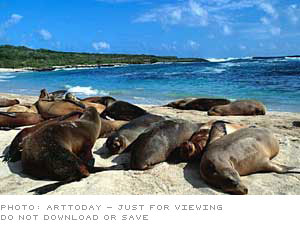|
When arriving in the Galapagos Islands, the first impression hitting any visitor is the tameness and “sociability” of all the animals living there, namely giant tortoises, sea wolves, otters, penguins, flamencos, land and sea iguanas, and a large variety of reptiles and birds. Some people even claim that sharks in these waters are “friendlier”. The Galapagos Islands are an archipelago made by 19 islands on the Pacific Ocean, some1000 kilometers off the Ecuador shore. Thus, these islands have belonged to Ecuador since 1832.
In 1535, the Bishop of Panama, Tomas de Berlanga, fortuitously discovered the isles. Because of their mysterious aspect, often shrouded by mist and fog, the lack of human presence and the exotic nature of its animals and plants, they were first named “Islas Encantadas” (Bewitched Islands). Since then, and until the mid 1800s, the archipelago was a heaven for pirates and whalers, lurking on the fauna, particularly giant tortoises because of their meat used for food. In 1835, Charles Darwin, the nature scientist who for 5 weeks had observed and recorded local floras and faunas, arrived on board the “Beagle” to the Galapagos shore. And it was the fauna of these isles that gave Darwin the key to his theory on the survival of the fittest.
On February 12, 1832, General Jose de Villamil took possession of the islands on behalf of the Ecuadorian Government. In 1924, William Beebe’s book The Galapagos – the End of the World, brought about a great interest among people from both the Americas and Europe resulting in the ecologic protection of the isles and a new trend – ecotourism as a means to wonder about and visit without hurting and lurking on nature. In 1973, the archipelago was declared a province of Ecuador and in 1978, UNESCO declared them a Natural Heritage of Mankind. In their beginning the isles emerged from the ocean due to volcanic activity. As they were so far away from the continental shell, they became a laboratory of nature. Plant and animal species capable of reaching the archipelago, developed over centuries with no foreign influence whatsoever, and only the fittest survived. Thus when the first human beings arrived, they found a virtually virgin place. In spite of man’s predatory practices and the imbalance caused by species brought by colonists and ships, this place is still salvageable for ecology.
However, it has been brutally ravaged. Out of 14 species of tortoises, only 11 survive. Of these, eight are listed as endangered species. The same is true for other animal and plant species. Fortunately, several legislations passed since 1932, the Charles Darwin Station commissioned in 1964, and the National Galapagos Park opened in 1968, have enhanced the rescue of all animal and plant species. Many exist only on this paradise with over 228 plant varieties or the black sea iguana making its habitat look as a pre-deluge site. Today, ecotourism is the main source of income for the Galapagos people. Of course, environmental protection standards are very stringent, as they should be. If man has caused the region’s imbalances, man must now protect this fragile ecosystem, which is a natural heritage of the Ecuadorian people, the Latinos, and the entire human race. The Galapagos Islands, an example of the best of the latin spirit. |
|
|
 Can
all wild Animals in a Region Be Tame and “Sociable” to
Man?
Can
all wild Animals in a Region Be Tame and “Sociable” to
Man?